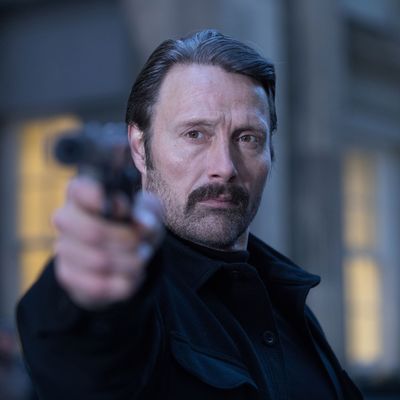
Ad directors turned feature directors seem to always fall into one of two extremely polarized (har har) camps. On the one hand, you have the David Finchers and Jonathan Glazers, directors who have found the right material to bring soul and narrative drive to their hyperspecific visual imaginations. And then you have guys like Jonas Åkerlund, a director proficient in surfaces (he’s directed timeless clips for Madonna, Beyoncé, and Lady Gaga), whose toe-dips into narrative work quickly reveals a lack of anything deeper.
If only the issue with Polar, Åkerlund’s fifth feature film, was merely shallowness. Polar is an execrable motion picture, a sad, lint-filled key bump scraped together from the bottom of the post-Tarantino ’90s exploitation baggie. It thinks it’s funny, but the only jokes it knows are smash-cuts to rails of cocaine and grievous bodily harm. By the time the team of dastardly assassins shoots up a morbidly obese Texan bystander in what feels like 30 seconds of flying gore and jiggling, shredded prosthetics, I mentally checked out. Excess and gore and Grand Guignol have a place in cinema, but I like to feel like someone with a sensibility more advanced than a 13-year-old’s is at the wheel.
The plot, in brief: Mads Mikkelsen plays Duncan Vizla, the world’s most deadly assassin, on the eve of his retirement. The syndicate he works for offers a generous pension for retirees, but they’d rather kill off their former employees than pay it. So four other assassins try to track Vizla down before his last day of employment. Vizla, haunted by the sins of his past, holes up in a cabin in Montana, where he befriends a neighbor (Vanessa Hudgens) who can perhaps help him regain his humanity.
The scenes between Mikkelsen and Hudgens are fine, because it’s the only time the film stops trying to make itself pass out from hyperventilation. Mikkelsen seems bored as hell throughout, playing such a one-dimensional badass, but Hudgens, dowdied up in a Carhartt and a flannel, has a bit of a spark to her. But the majority of the film is given over to the assassins’ trail to Vizla’s cabin, and Åkerlund ensures we never go too long without getting our faces smushed in a pair of implants, or following the AssCam behind Ruby O. Fee’s Sindy, the requisite “sexy one.” There’s no irony to any of this; none of it means anything. At one point, the film has the lobotomized nerve to attempt a straight-faced #MeToo moment in the middle of all the T&A, after Sindy is assaulted by a perv and then violently stabs him to death to make it all better.
The irony of all this noise is that the original webcomic on which Polar is based is silent — or at least, dialogue-free. Victor Santos’s frames are stark and graphic, rendered in bold, often abstract strokes of black and red. It’s not the most original stuff, story-wise (there’s some Oldboy in there, definitely some Natural Born Killers), but visually it certainly has confidence and pull. Dark Horse added speech bubbles and dialogue when it bought the series, making it a little more legible as a potential mainstream property. Writer Jayson Rothwell, added to this game of not-so-Exquisite Corpse, and Åkerlund built from that a film so insecure, so faithless in its audience’s attention span, that he literally punctuates every scene cut with a gunshot. There’s none of the gory grace of Santos’s original frames; cinematographer Pär M. Ekberg appears to have shot it through the Edgelord Instagram filter, all senselessly saturated, contrasted-to-shit colors.
What’s depressing is that not only is the movie such a slog in its desperation to be edgy, but it also shows little development in its idea of edginess from Åkerlund’s clip for the Prodigy’s “Smack My Bitch Up,” famously banned from MTV in 1997. It’s all the same drugs, sex, and violence, shot through the same lens, for its own sake. Neither contribute too much to humanity, but one takes a lot less time to watch.

